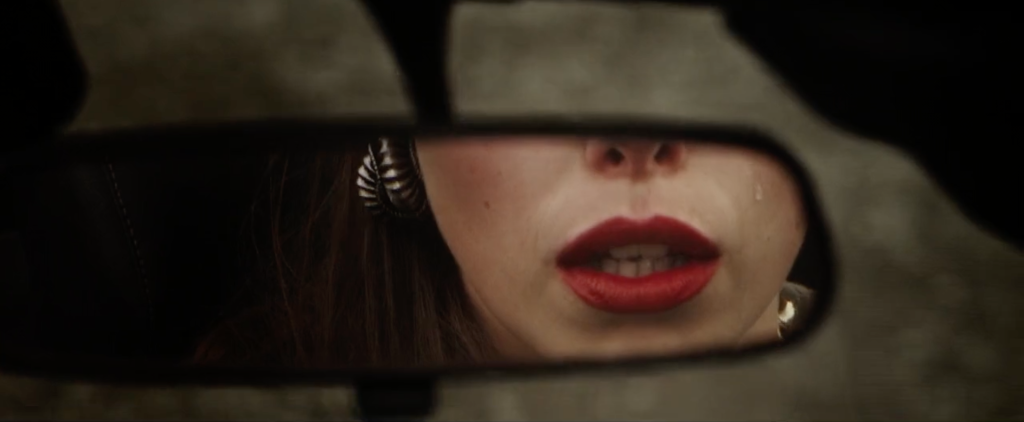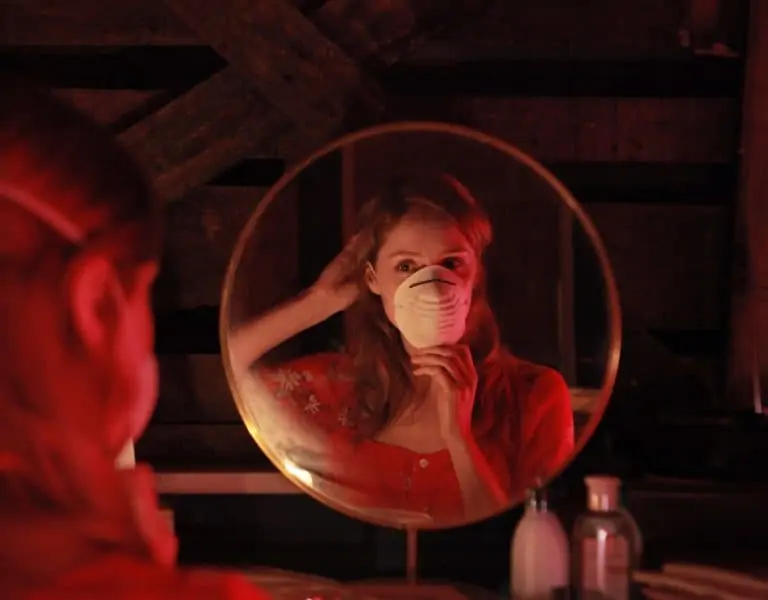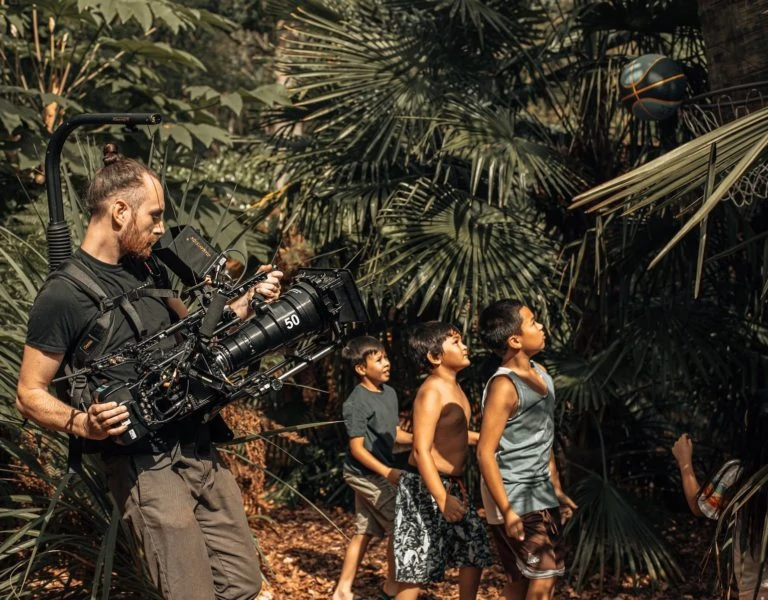Creative possibilities
Selected filmography so far:
Film: Embers (dir. Christian Cooke, 2023); Hounded (dir. Tommy Boulding, 2022); Rose (dir. Jennifer Sheridan, 2020); Petroleum Spirit (dir. Rob Sanders, 2015)
TV: Silverpoint (dir. Dan Zeff, Marek Losey, 2015)
Documentary: The Ghost Rainforest (dir. John Davies, 2022)
When did you discover you wanted to be a cinematographer and what inspired you to follow this career path?
My dad taught me photography when I was seven years old, and from that moment on I used to take photos on my analogue Zenit, using manual aperture, focus, light meter and calculating the shutter speed. These first photos were a play on composition and colour, and I think I took more than 2,000 photos by the age of 15, some of which we developed together. It was one of not too many things we could do together – he was an engineer and I always loved art, but photography seemed to make that bridge.
I always wanted to be a painter. During my first year of arts school, I saw rushes from S16mm film I shot and I realised film makes the images I dream of come to life. The new possibilities using the emulsion I knew quite well enticed me, and moving light entered my imagination.

Where did you learn your craft?
Arts University Bournemouth, and five years of camera assisting after that. I learned from incredible DPs and their teams, including having the rare pleasure to work with Ralph Ramsden who explained to me a lot of technical aspects of filtration, sacrificing his every lunch break.
I got to work with great gaffers and was constantly filling notebooks with thoughts and lighting plans… Richard Bradbury taught a vast amount about of lenses and set etiquette. On every new project the challenges are getting bigger and I am learning something new, but I am lucky to bring these strong foundations into my craft now.
What are your favourite films, and what makes them stand out to you?
I love films which transport the audience straight to the story: Gus Van Sant’s Elephant (cin. Harris Savides ASC); Darren Aronofsky’s Requiem for a Dream (cin. Matthew Libatique ASC); Tom Tykwer and cinematographer Frank Griebe’s films, especially their early work such as The Princess and the Warrior; anything shot by Jean-Yves Escoffier AFC… At the same time I am fascinated by the camera work which disappears serving a great story, such as Robert Richardson ASC’s work on Platoon.

Who in the film world inspires you?
People who break boundaries using their life to make art. Ellen Kuras ASC for mixing formats, and going against the grind. Eric Gautier AFC for bringing minimum crew to shoot Into the Wild, overcoming great challenges and discovering a new way of shooting an epic drama through these limitations. I am inspired by Robert Elswit ASC’s work with Paul Thomas Anderson, where the whole crew is in tune with the director, to not interrupt the process of working with actors, achieving visual perfection. I remember reading about it in the ASC magazine back when I was at film school and when I got to work like this on my latest feature film Embers, it was unbelievably rewarding.
What’s the most useful advice you’ve received and from whom?
Benoît Delhomme AFC told me to transition to DP after assisting for him in 2015, and to follow my heart. I’ve still got that email. It helps me to find the power to keep going. He also inspired me to go back to painting, I recently got my first art studio – I am also finishing my fiction book – I think he is still a big inspiration for me to combine art and cinematography, and calling yourself “an artist” without feeling shy about it.

What advice would you give someone considering becoming a cinematographer?
Watch the world around you for any sublime changes, and express this in your work through images. Be brave. Remember whatever you invest your time in is worth more than any money, so choose projects that can push the limits of your imagination. Learn about the craft and technology – it is freeing. I used to watch light on walls, and remember it to then reproduce it on my films.
Also book a day at Movietech, One Stop or ARRI – the colleagues at rental companies are incredibly helpful and knowledgeable – and test some lenses – you can see which ones correspond with your vision, and perhaps fall in love with some. Try to get a camera with some cheaper versions of lenses you like – it helps to land your first jobs. I am just getting my drone licence – having a small drone helps to see a lot of new angles.
What have been your greatest triumphs and disasters on set?
Disaster: I never opened a loaded mag! I once went to Madeira to shoot Garden of Eden and we had no wet weather gear because “it never rains there”. Imagine the whole crew covered in bin bags – it was tipping it down.
Triumph: Working with Jennifer Sheridan on our first TV drama, Snow Spider felt like a dream. Our producer Lindsey Hughes made the set so friendly. Also making teenagers fly in a forest with Dan Zeff on Silverpoint felt so satisfying, I really enjoy overcoming technical challenges and prep, which involves the whole team.
The best ever moment was last year with Christian Cooke on Embers, a new feature film which just premiered at Raindance, when the gaffer, James Duffy, and I finished the main 360 lighting set up, sparked it, and it all worked seamlessly.

What lights your fire outside of work?
Painting on acrylic see-through sheets, tracing over reality. Jack Cardiff BSC used to do it on glass filters back in the day! Skateboarding, hiking, nature, getting stuck in community driven projects. I am from a council estate in Poland, so it is nice to give something back. I also live in an artist commune and creating multidisciplinary projects with my talented musician housemates, VR artists who work on the Neuralink brain interface, and other creatives feels incredible.
What has been the biggest challenge in your career and how did you overcome it?
Being a foreigner, being a woman, coming from a poor family, not knowing anyone. I am just a really friendly person, who loves art, other people and what we do, and maybe it helps people to look past the differences. I am really thankful to some incredible DPs who I used to assist, such as Angus Hudson BSC, who often say a few words of kindness and approval, which keep me going in harder times. The illuminatrix collective is another community which has been incredibly helpful in ups and downs of the freelance life.

What piece of kit could you not live without?
My dioptres! I take them to every set – I also carry a magnifying glass, and selection of prisms mountable on a matt box. Especially when shooting any kind of nature, these help me to focus on the intricacy of microcosmos around us. Sometimes I feel I can’t live without Henry Owen, my first AC, who keeps me company, teaches me about British banter, and is super sharp.
Which film would you love to have shot?
Apocalypse Now – I’d love to shoot a very big technically challenging piece with a great story in a difficult location! In my career I’ve shot many commercials and documentaries in obscure parts of the world, and I love working with local crews to achieve the impossible.
Which productions are you most proud to have lensed, and why?
Rose, by Jennifer Sheridan. Jen is just so incredibly sensitive to the story, editing it as we shoot. I enjoyed bringing ideas to the table, discussing it with Jen over recces and dinners, watching films to build an understanding, walking through locations finding places we loved for specific scenes. We became great friends during that filming process. Operating in the snow with a gimbal, on very old Lomos, creating from scratch the world her characters could inhabit, with a great team, was an incredibly exciting opportunity.

What’s the best and worst thing about your job?
That feeling when you’re shooting something extraordinary, and you become immersed in it. And the wrap afterwards, when you don’t know what you will shoot next!
I love shooting and I wish more people could find jobs they love. Mine reminds me of casting shadows in ancient theatres on stone walls, to tell stories, we just use lenses and lights instead of the fire now… mostly.
How would you best describe your approach to cinematography?
For me it is a mix of technical expertise, working with specialists, to achieve the vision behind the script. A lot of love to the world. Sensitivity to natural beauty which lies within all of us. This possibly sounds quite spiritual, but I truly feel there is magic in us, and cinematography is a way for me to capture it.

What are your aspirations for the future?
I think films help people from seemingly very different countries and backgrounds see common denominators in their life. Perhaps that is why the story of a young girl from English council estates in Fish Tank resonated with me, although I was brought up in post-communist Poland. I would love to shoot films which can change the world, by making us see what we have in common, rather than our differences.
It is a treasure to use analogue ways of expressing, shoot on film, and in the future I imagine combining it with animation and ultra-modern technology to creating images which I have never seen before. Translating great scripts into the light, with inspiring filmmakers frees my imagination. In the future I dream of having a kind of design, filmmaking and music studio where I can work with great talent to make interdisciplinary films, and use spare resources to help anyone learn filmmaking.
What do you think are the industry’s biggest challenges?
Coming together to overcome challenges, rather than finding divisions between departments. Supporting each other. I would love us to be more open with each other, and honest – we are all in it together. Finding the freedom in technological advancements, and, as skaters say “keeping it real” – staying true to our storytelling roots at the same time.










